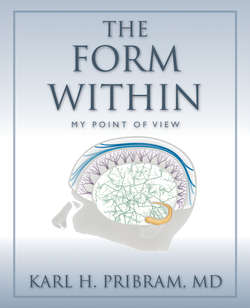Читать книгу The Form Within - Karl H Pribram - Страница 28
На сайте Литреса книга снята с продажи.
Engaging Lashley
ОглавлениеI could see only one alternative, one that provided a middle way between the direct currents of Köhler and the lines and stick figures of Hubel and Wiesel. Years earlier, during the 1940s, when I had been involved in research at the Yerkes Laboratory, its director Karl Lashley had suggested that interference patterns among wave fronts in brain electrical activity could organize not only our perceptions but also our memory. Lashley, a zoologist, had taken as his model for patterning perception those developmental patterns that form a fetus from the blastula stage to the fully developed embryo. Already, at the turn of the 19th century, the American zoologist Jacques Loeb had suggested that “force lines” guide such development. At about the same period, A. Goldscheider, a German neurologist, had wondered if such force lines might also account for how the brain forms our patterns of perceptions.
Lashley’s theory of interference patterns among wave fronts of electrical activity in the brain had seemed to suit my earlier intuitions regarding patterned (as opposed to DC) brain electrical activity. However, Lashley and I had discussed interference patterns repeatedly without coming up with any idea of what micro-wave fronts might look like in the brain. Nor could we figure out how, if they were there, they might account for anything at either the behavioral or the perceptual level.
Our discussions became somewhat uncomfortable with regard to a book that Lashley’s postdoctoral student, Donald Hebb, was writing at the time. Lashley declined to hold a colloquium to discuss Hebb’s book but told me privately that he didn’t agree with Hebb’s formulation. Hebb was proposing that our perception is organized by the formation of “cell assemblies” in the brain. Lashley could not articulate exactly what his objections were: “Hebb is correct in all his details, but more generally, he’s just oh so wrong.” Hebb was deeply hurt when Lashley refused to write a preface to his book—which nonetheless came to be a most influential contribution to the brain/behavioral sciences.
In hindsight, it is clear that Hebb was addressing brain circuitry, while Lashley, even at such an early date, was groping for an understanding of the brain’s deeper connectivity and what that might mean in the larger scheme of psychological processes.
With respect to my colleague Jack Hilgard’s problem of needing an answer about brain processes in perception in time for his publication date, I took his query to my lab group, outlining both my objections to Köhler’s DC fields and to Hubel and Wiesel’s stick figures. I suggested that since there were no other alternatives available right now, perhaps Lashley’s proposal of interference patterns might be worth pursuing. Not totally tongue-in-cheek, I noted that Lashley’s proposal had the advantage that we could not object to something when we had no clue of what was involved.
